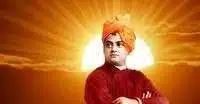
Swami Vivekananda
Vivekananda was born as Narendranath Datta on 12 January 1863. He was an Indian Hindu monk and chief disciple of the nineteenth-century saint Ramakrishna. His father, Vishwanath Datta, was a successful attorney, and his mother, Bhuvaneshwari Devi, was endowed with deep devotion, strong character and other qualities. With his knowledge and efforts, he proved to be a key figure in introducing the Indian philosophies of Vedanta and yoga to the Western world. Swami Vivekananda’s inspiring personality was well-known, both in India and America in the late 19th and early 20th century.
A talented boy, Narendra excelled in music, gymnastics and studies. By the time he graduated from Calcutta University, he had acquired a vast knowledge of different subjects, especially Western philosophy and history. Born with a yogic temperament, he used to practice meditation from his boyhood days. In his early youth, he was entangled with doubts about the existence of God. This made him meet Sri Ramakrishna, who was staying at the Kali Temple in Dakshineshwar. Apart from removing doubts from the mind of Narendra, Sri Ramakrishna won him over and thus began a guru-disciple relationship between them.
After a few years, two events caused Narendra considerable distress: one was the passing away of his father and the other was when Sri Ramakrishna gave up his mortal body. After this, in 1887 he took the formal vows of sannyasa, thereby assuming a new name. Narendra now became Swami Vivekananda. Soon, Vivekananda heard the inner call for a greater mission in his life. His master taught him that service to men was the most effective worship of God. He realised the importance of Sri Ramakrishna’s message and decided to spread it to the modern world and to India in particular.
Narendra travelled extensively in India, acquainting himself with diverse religious traditions and social patterns. During his travels, he was deeply moved to see the terrible poverty and backwardness of the masses. He was the first religious leader in India to understand and openly declare that the real cause of India’s downfall was the neglect of the masses.
One thing became clear to Swamiji- to carry out his plans for the spread of education and upliftment of the poor masses, and women, an efficient organisation of dedicated people was needed. To serve this need, Swamiji founded the Ramakrishna Mission a few years later. He started his journey to the West by visiting cities of Japan, China and Canada. He also heard about the World’s Parliament of Religions to be held in Chicago in 1893. He felt that the Parliament would provide the right forum to present his Master’s message to the world, and so he decided to go to America.
His speeches at the World’s Parliament of Religions made him famous as an ‘orator by divine right’ and as a ‘Messenger of Indian wisdom to the Western world’. After preaching in parts of America and London, Swamiji returned to India to inspire his own people. While in the West, Vivekananda spoke about India’s great spiritual heritage; in India, he repeatedly addressed social issues: uplifting the people, eliminating the caste system, promoting science and industrialisation, addressing widespread poverty and ending colonial rule. Netaji Subhash Chandra Bose once wrote: “Swamiji harmonised the East and the West, religion and science, past and present. And that is why he is great. Our countrymen have gained unprecedented self-respect, self-reliance and self-assertion from his teachings.”
On 4 July 1902, Vivekanada left his mortal body and attained, “mahasamadhi”. Vivekananda revived Hinduism within and outside India and was the principal reason for the wholehearted reception of yoga, transcendental meditation and other forms of Indian spiritual self-improvement in the West. He derived his ideas from the vast source of knowledge and wisdom he possessed and often presented them in the language of poetry. His life and teachings are of great value to all.